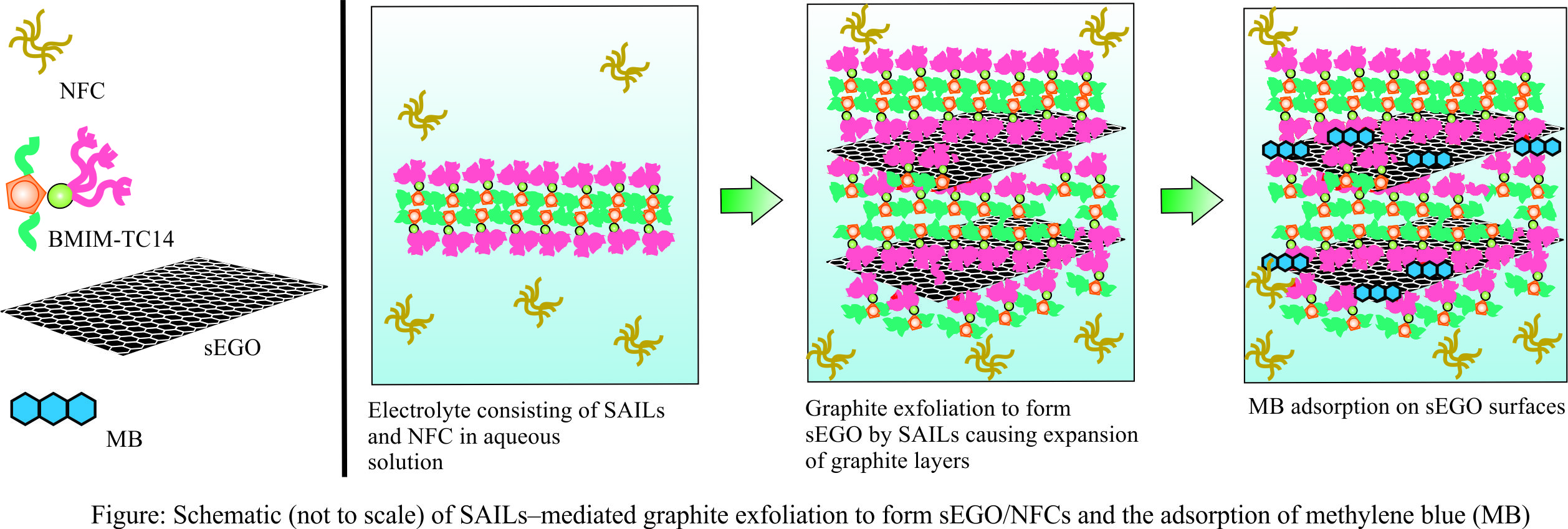Industrially-produced dyes emitted in waste water must be removed before the water can be released into the environment. Practically, different methods are used for water treatment, including adsorption, which is commonly used to remove organic molecules, including dyes.
A new family of these adsorption materials is based on graphene oxide (GO). As well as a high surface area, beneficial to adsorb a lot of dye, these GO derivatives have an electronic structure that attracts aromatic portions of the dye molecules, and additionally, oxygen-containing groups that can bond with other parts of the dyes.
However, during the adsorption process, layers of GO can build up and form aggregates reducing the efficiency of this method. One way to avoid this problem is by forming a hybrid material with GO and nanofibrillated kenaf cellulose (NFC), stabilised by surfactants and/or ionic liquids to make these hybrid materials compatible with water.
NFC comes from a fibrous material derived from the Kenaf tree (Hibiscus cannabicus L.), which is an alternative to cellulose produced from wood. It can be processed into pulps, as well as turned into biocomposites. Kenaf can be grown in a wide range of climatic conditions and requires low capital investment. These economic and ecological advantages make Kenaf-based materials a promising alternative feedstock.
An international partnership between researchers at Malaysian Universities led by Associate Professor Dr Azmi Mohamed from Universiti Pendidikan Sultan Idris, Hirosaki University in Japan led by Associate Professor Dr Masanobu Sagisaka, Professor Julian Eastoe from University of Bristol, and ISIS scientists Dr Stephen King and Dr Sarah Rogers has developed new surfactants needed to realise this application. The project has been supported by the Newton Fund through use of the ISIS Neutron & Muon Source to explore the self-assembly of surfactants and ionic liquids on the graphene oxide surfaces, which are key for the process to work.
This study, published in PCCP, explores one such system, and describes a novel one-pot approach to the synthesis of the all-important nanocomposites. Using this new method, nanocomposites comprising GO, NFC and surfactants were made, characterised and then tested for removal of a typical pollutant dye, methyl blue, from water.

Using a variety of techniques, including small-angle neutron scattering (SANS) on the LOQ instrument at ISIS, the researchers were able to determine that their straightforward and economical synthesis technique was successful in producing the nanocomposites. Not only that, but these nanomaterials were able to adsorb 99% of the methyl blue dye molecules from solution.
Based on the SANS results a mechanism was proposed accounting for the action of the nanoadsorbents: changing the headgroup of the surfactant had a notable impact on the efficiency of the process. With this new synthesis method, and the knowledge of how the adsorption takes place, this study opens up new opportunities for designing future systems that could reach 100% dye removal.
Further information
The full paper can be found at DOI: 10.1039/D1CP02206G
